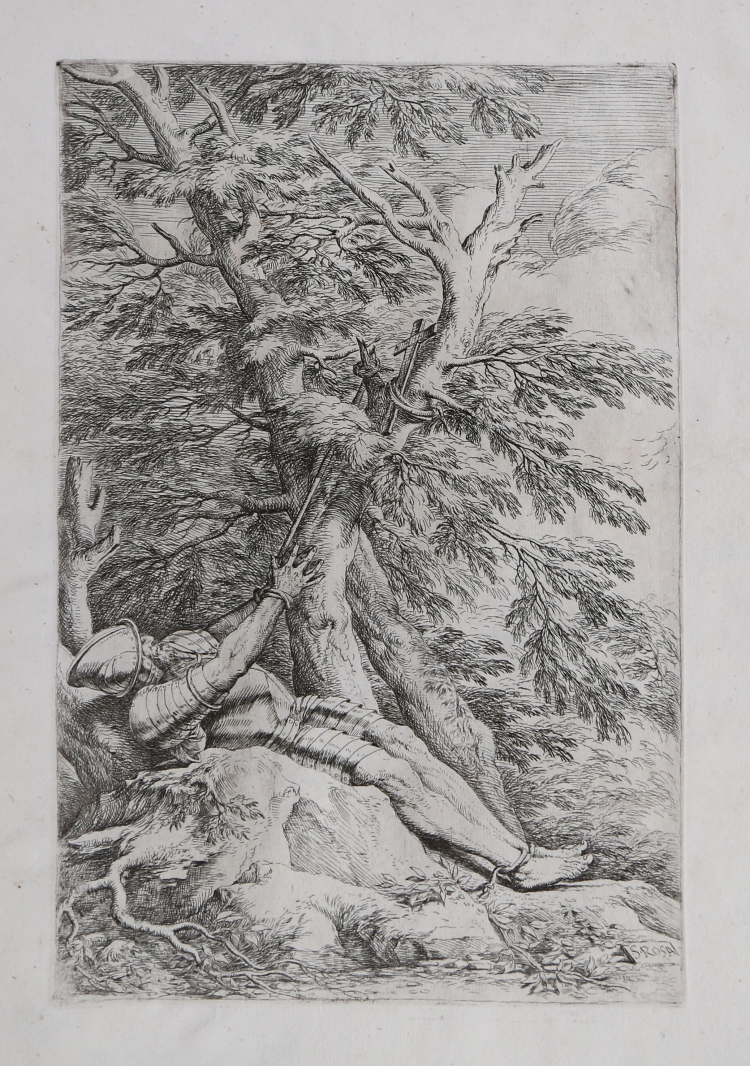




| Reference: | S24577 |
| Author | Salvator ROSA |
| Year: | 1661 ca. |
| Measures: | 235 x 355 mm |



| Reference: | S24577 |
| Author | Salvator ROSA |
| Year: | 1661 ca. |
| Measures: | 235 x 355 mm |
Etching with drypoint, 1661 circa, signed at lower right.
Example of the second state of two. A fine impression, printed on contemporary laid paper with "encircled fluer-de-lys" watermark, wide margins, perfect conditions.
St. William of Maleval, also known as William of Aquitaine, was a hermit, contemplative, whose teachings, collected by his disciple Alberto who lived with him his last year of life, and in Consuetudines Regula sancti Guillelmi, gave rise to 'order of St. William. It is revered as a saint by the Catholic Church.
St. William was an immoral soldier who later took up a monastic life. He is depicted here doing penitence in a forested valley in a region of Siena known as Maleval. Rosa presents the saint as a solitary penitent figure tensely situated in an uncomfortable pose and quietly contemplating a cross. The loneliness of the figure is augmented by the jagged style in which the forest is rendered, especially through the extreme gradations of shading. The theme of the contemplative penitent is common in works by Rosa as also seen in the Metropolitan's Museum Self-Portrait where the artist represents himself as a scholarly penitent.
A great example.
Bibliografia
Bartsch / Le Peintre graveur (XX.268.1); Wallace 1979 / The Etchings of Salvator Rosa (99.II); Theodoli 99; Salamon 85.
Salvator ROSA (Napoli 1615 - Roma 1673)
|
Like Testa, Castiglione and Della Bella, Salvator Rosa considered the art of engraving the best technique to express his talent and, it is not by chance that he is considered, together with the already mentioned artists, one of the protagonists of Italian seventeenth-century art.
Rosa was an extremely eclectic person; his main models in art were the classicism of Carracci, the naturalism of Ribera, the contemporary Roman painting and the ancient world.
From the latter in particular, Rosa drew inspiration for his engravings, whose subjects come from the old Stoic philosophy, with the glorification of virtues though allegories. We have also to consider his passion for esotericism, which inspired him with pictorial compositions with necromancy.
His technique and total command of etching enabled his prints to be appreciated even from his contemporaries, copied by them and highly requested by collectors.
|
Salvator ROSA (Napoli 1615 - Roma 1673)
|
Like Testa, Castiglione and Della Bella, Salvator Rosa considered the art of engraving the best technique to express his talent and, it is not by chance that he is considered, together with the already mentioned artists, one of the protagonists of Italian seventeenth-century art.
Rosa was an extremely eclectic person; his main models in art were the classicism of Carracci, the naturalism of Ribera, the contemporary Roman painting and the ancient world.
From the latter in particular, Rosa drew inspiration for his engravings, whose subjects come from the old Stoic philosophy, with the glorification of virtues though allegories. We have also to consider his passion for esotericism, which inspired him with pictorial compositions with necromancy.
His technique and total command of etching enabled his prints to be appreciated even from his contemporaries, copied by them and highly requested by collectors.
|